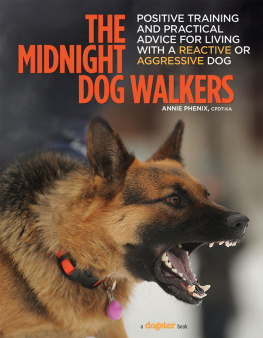
Teaching the Reactive Dog Class
Leading the Journey from Reactivity to Reliability
Karen Pryor Clicker Training
Sunshine Books, Inc.
49 River Street, Suite 3
Waltham, MA 02453 USA
U.S. (Toll Free) 800-472-5425
781-398-0754
www.clickertraining.com
For information about special discounts for multiple-copy purchases, please contact Karen Pryor Clicker Training sales:
U.S. (Toll Free) 800-472-5425 or 781-398-0754 or .
2014 by Emma Parsons
Editing: Nini Bloch
Cover/book design: Rosamond Grupp
Photographs: Gregory Charles Parsons
All rights reserved, including the right to reproduce this book or portions thereof in any form whatsoever.
First edition published 2014
ISBN-10: 1-890948-47-4
ISBN-13: 978-1-890948-47-4
Library of Congress Control Number: 2011944959
To the Lord God who made them all
Contents
Chapter 7
Week One: Clicker Training 101
Chapter 8
Week Two: The Dress Rehearsal
Chapter 9
Week Three: Show Time!
Chapter 10
Week Four: I See It!
Chapter 11
Week Five: I See It, but What Do You Want Me to Do?
Chapter 12
Week Six: Lets Jump for Joy!
Introduction
I have been both an owner and a trainer of reactive dogs.
Many of you may know me from reading Click to Calm, a book written in tribute to my dog, Ben. For those of you unfamiliar with his story, Ben was a dog so reactive to other dogs that over-threshold encounters with triggers resulted in his barking, lunging, and even vomiting from the stress.
Life with Ben taught me many lessons and made me a better trainer. While I knew he changed my own life in ways both profound and unexpected, little did I know that Bens story and the training techniques that helped us live together more joyfully would inspire so many others, professionals and pet owners alike, to follow suit in pursuing positive training techniques to solve similar behavior problems.
If you are currently working with reactive dogs or would like to move your career in that direction, it is likely that you, too, have known and loved a dog like Ben. If that is true, you know that living with a reactive dog can be tough, especially if you lack the knowledge or skills needed to help your dog feel better about the world around him. Owners of reactive dogs may feel frazzled, frustrated, discouraged, or hopeless. Worst of all, it can be a lonely feeling. It can feel, sometimes, as if you are navigating a world of friendly dogs and people who just cant understand what you and your dog are going through. You may have found yourself craving a support group, one where everyone understands what you mean when you say, You know, hes really a wonderful dog, except when
Many trainers who include behavior modification for reactivity and aggression in their offered services have experienced the same feelings of being isolated and misunderstood. It is easy to have great passion and enthusiasm for helping your clients through similar situations, but it can also be demanding. These clients may well be feeling hopeless and at the end of their rope. In many cases, a client will tell you about her dog, You are his last shot. These clients require a lot of support and encouragement and, in fact, may need more training than the dog you are being hired to help.
Traditionally, clients seeking assistance for reactivity and aggression are seen in a series of private lessons. Trainers working with such clients face myriad challenges: Will we find an overly friendly and poorly trained off-leash dog at the normally quiet park? Will my assistant and my client be available at the same time for next weeks lesson so I have someone on hand to work with a trigger dog? This case will require multiple sessions to see a successful resolution. Can my client commit the time and money required to purchase an appropriate package of private sessions? It is certainly possible to guide your clients successfully in rehabilitating their dogs through private lessons, but is it the best, only, or most efficient way to help them?
After honing my skills in treating canine reactivity and aggression with Ben, I felt a strong desire to help others similarly. I traveled significant distances to help pet owners with dogs like Ben. These road trips provided me with a lot of time to think, and one of the thoughts that continually popped into my head was, Could I help more dogs if I could get these dogs safely into a group-class environment? If possible, such a class really seemed as if it would be a win-win-win for each cog in the training wheel: trainer, owner, dog. A trainer who was able to conduct a group class successfully would decrease the time investment per client, increase the number of dog/handler teams she could help, and, potentially, grow her business exponentially, since there certainly is a great need for such a service. Clients would find training more affordable than a similar number of private sessions. They would also benefit both from being part of a support group of other handlers who were working through similar problems with their own dogs and from the opportunity to practice multiple exposures in a heavily controlled environment where they would feel safe and not embarrassed. And the dogs? Nothing could be better for them than to learn the skills needed to successfully navigate an environment replete with former triggers.
There were many logistic issues to consider, obviously. Was such a class even possible? If one dog/handler team dealing with reactivity issues was a challenge, how would dealing with many such teams in a single room be easier or more effective? One of the sacred cows of training reactive dogs is to be sure to keep them under threshold to prevent rehearsal of the unwanted behavior. Would placing numerous such dogs all in the same room together exacerbate the very problems we were trying to address?
These were the questions that ran through my head when I started to wonder whether the techniques from Click to Calm could be modified successfully to work in a group-learning environment. Fran Masters, owner of MasterPeace Dog Training in Franklin, Massachusetts, was curious as well and willing to allow me to experiment with such a class at her facility. We needed a minimum of six dog/handler teams to make this venture financially viable for both of us. There was a caveat, however: there would be no screening of the dogs prior to class, no private lessons building foundation behaviors in the dogs and handlers, no detailed history-taking, no accoutrements that generally are associated with the process of initiating a training relationship in such cases.
Lets do it, I said.
I thought about Ben. What kind of class would he have benefited from? Ben and I would have wanted an environment that was well controlled; where I felt as if I had the skills and tools needed to manage him successfully and keep him under threshold. Ideally, I would have loved to take a class where I felt as if I had a helper who was committed to guiding and protecting us through the learning process. Visual barriers would be helpful, as would someone who could coach me about when and how to move past their use. Having trained numerous reactive dogs and the people who loved them, I was able to envision what I hoped would be an optimal learning environment. I created a class built around these thoughts and the training techniques from Click to Calm.
This was no small task and carried substantial risk: at best, the teams would see great improvement together. At worst, the behavior problems we were trying to solve would deteriorate, endangering the lives of the very dogs I hoped to help.
Next page








